Garment Meaning In The Bible: Righteousness and Identity
In biblical contexts, garments symbolize various theological and spiritual themes, illustrating divine and human interactions. Joseph’s coat of many colors signifies favoritism and incites jealousy, catalyzing significant narrative events.
The Priestly Garments represent sanctity and divine authority, while sackcloth denotes repentance and mourning. Elijah’s mantle symbolizes prophetic succession, and Jesus’ seamless robe reflects divine perfection.
From Adam and Eve’s fig leaves highlighting human vulnerability to the Prodigal Son’s robe denoting restoration, clothing carries rich metaphorical weight. In addition, tearing garments in grief and the ‘Armor of God‘ underscore spiritual states and defenses.
Each instance unfolds deeper spiritual truths and divine revelations.

Garment Meaning in the Bible: Symbol of Righteousness, Identity, and Transformation
| Aspect | Biblical Insight |
|---|---|
| Definition | A piece of clothing, often symbolizing spiritual condition or status |
| Old Testament Reference | Isaiah 61:10 – “He has clothed me with garments of salvation…” |
| New Testament Reference | Revelation 7:14 – “They have washed their robes and made them white…” |
| Symbolism | Righteousness, purity, spiritual identity, and readiness for God’s presence |
| Spiritual Application | Represents putting on Christ and living in holiness and spiritual renewal |
Joseph’s Coat of Many Colors

Among the myriad of garments mentioned in the Bible, Joseph’s coat of many colors stands out as a symbol of favoritism, familial discord, and divine destiny.
This multicolored tunic, given by Jacob to his son Joseph, reveals Jacob’s preferential love, inciting jealousy and enmity among Joseph’s brothers (Genesis 37:3-4).
The garment’s vivid hues serve as a visual metaphor for the complex emotions and events it catalyzed, leading to Joseph’s sale into slavery and subsequent rise to power in Egypt.
Scholarly interpretations often emphasize the coat’s role in the narrative arc, marking Joseph’s journey from favored son to pivotal figure in God’s providential plan.
Consequently, the coat encapsulates themes of divine purpose intertwined with human imperfection.
The Priestly Garments
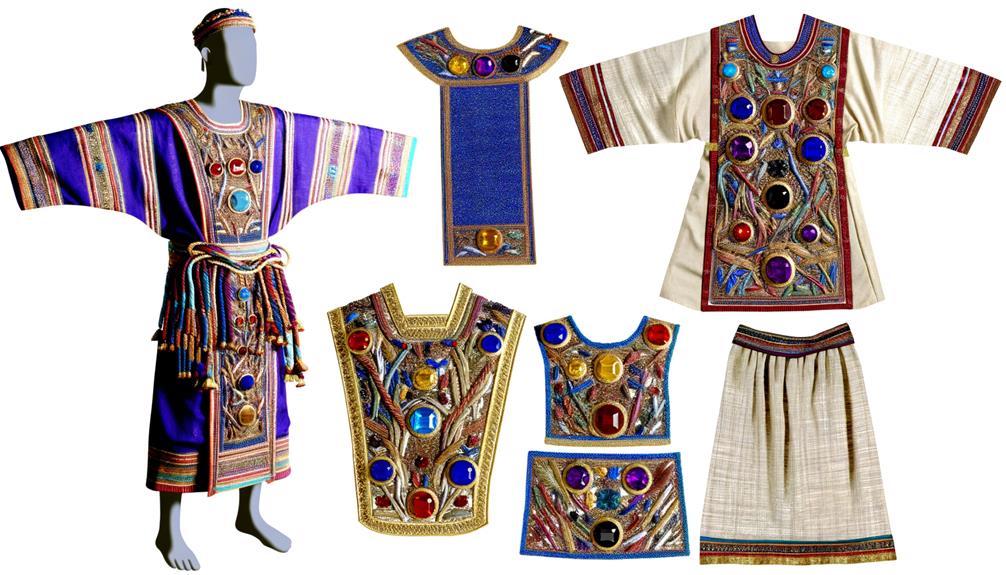
While Joseph’s coat of many colors symbolizes personal destiny and familial tensions, the priestly garments described in the Bible represent divine authority, sanctity, and the intricate relationship between God and His chosen intermediaries.
Detailed in the Book of Exodus, these garments include the ephod, breastplate, robe, tunic, turban, and sash, each imbued with symbolic significance. The ephod, adorned with twelve stones representing the tribes of Israel, underscores the high priest’s role as a mediator.
The Urim and Thummim, embedded within the breastplate, signify divine guidance. The meticulous craftsmanship and sacred materials—gold, blue, purple, and scarlet threads—reflect the garments’ holy purpose.
These vestments not only distinguish the priesthood but also reinforce the theological framework of divine order and ritual purity.
Sackcloth and Repentance
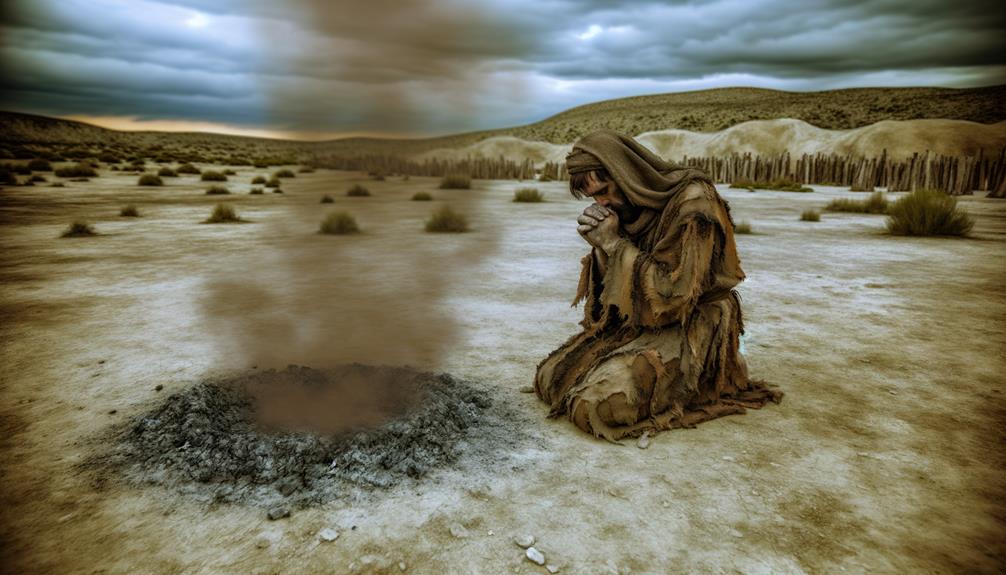
Sackcloth, a coarse material typically made from goat or camel hair, serves as a potent symbol of repentance and mourning throughout various biblical narratives. Its abrasive texture signifies the discomfort and humility associated with sincere contrition.
In passages such as Jonah 3:5-6, the inhabitants of Nineveh don sackcloth as a collective act of penance, seeking divine forgiveness. Similarly, King David, in 2 Samuel 3:31, dons sackcloth to mourn Abner’s death, underscoring sackcloth’s role in expressions of profound grief.
The material’s symbolic weight underscores a physical manifestation of inner remorse and supplication, reflecting an earnest appeal to God. This attire, consequently, transcends mere fabric, embodying a theological dialogue between humanity and the divine through visible acts of repentance.
The Mantle of Elijah

The mantle of Elijah, a distinctive and significant garment within the biblical tradition, represents a profound symbol of prophetic authority and divine empowerment.
This mantle, or cloak, was not merely a piece of clothing but a tangible representation of Elijah’s prophetic office and the power bestowed upon him by God.
In 2 Kings 2:13-14, Elijah’s mantle is passed to Elisha, signifying the transfer of prophetic authority.
When Elisha strikes the Jordan River with the mantle, it parts, mirroring Elijah’s earlier miracle and confirming Elisha’s newly endowed spiritual authority.
Consequently, the mantle serves as an emblem of continuity within the prophetic tradition, highlighting the transmission of divine power and the enduring nature of God’s covenant with His prophets.
Jesus and the Seamless Robe
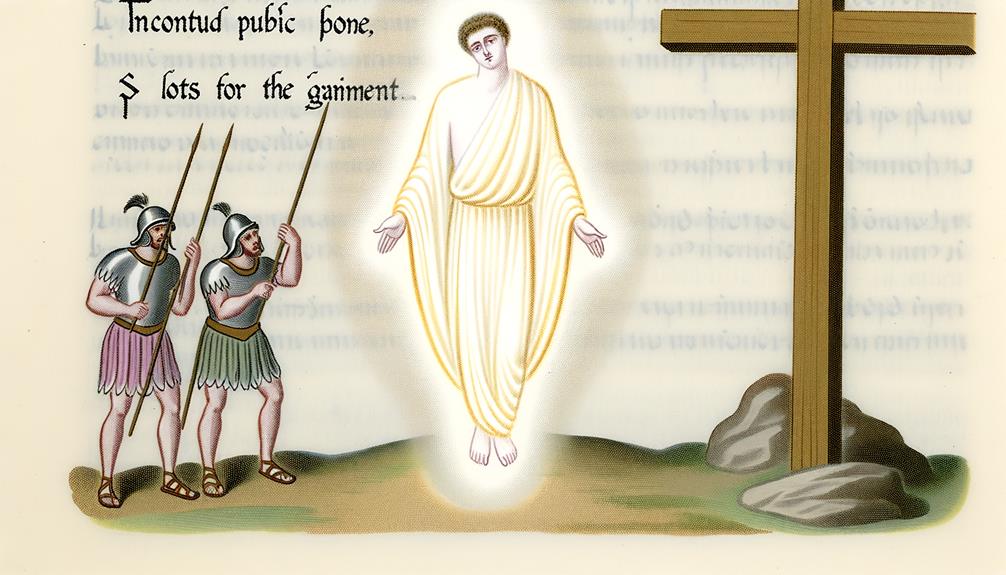
In the Gospel of John, the seamless robe of Jesus emerges as a potent symbol of His divine uniqueness and the unity of His ministry.
This garment, described as ‘woven in one piece from top to bottom’ (John 19:23), signifies the indivisibility of Jesus’ mission and His divine nature. The seamless construction implies perfection, mirroring the wholeness of Christ’s teachings and life.
When Roman soldiers cast lots for His robe, it fulfilled the prophecy in Psalm 22:18, underscoring the robe’s prophetic and messianic significance.
This act of not tearing the robe further symbolizes the preservation of divine truth and continuity, reflecting Jesus’ role as the unifying force of Christian faith, whose message remains undivided and pure.
Clothing in Parables

Building on the profound symbolism of Jesus’ seamless robe, parables in the Bible frequently employ clothing as a metaphor to convey deeper spiritual truths and ethical teachings.
In the Parable of the Wedding Feast (Matthew 22:1-14), the guest without a wedding garment symbolizes the unprepared soul, lacking righteousness and unworthy of the Kingdom of Heaven.
Similarly, in the Parable of the Prodigal Son (Luke 15:11-32), the father bestowing a robe upon his repentant son signifies forgiveness and restoration.
These narratives utilize garments to underscore the necessity of spiritual readiness, repentance, and divine grace.
Through such vivid imagery, biblical parables invite reflection on one’s moral and spiritual state, enhancing the didactic power of Jesus’ teachings.
Heavenly Robes in Revelation
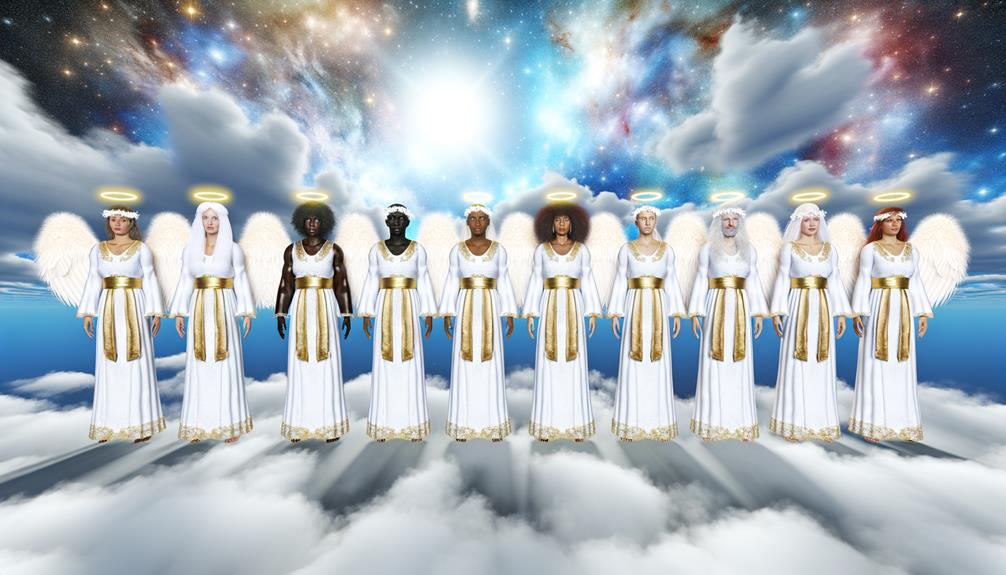
Revelation, the final book of the New Scripture, vividly depicts heavenly robes as symbols of purity, victory, and divine approval.
White garments, frequently referenced, signify the righteousness of the saints, who have been cleansed by the blood of the Lamb (Rev. 7:14). These robes also connote triumph over spiritual adversaries, reflecting the victorious nature of those who remain steadfast in faith.
Additionally, the garments represent divine approval, as those who wear them are often described as blessed and worthy (Rev. 3:4-5).
The imagery of heavenly robes, consequently, encapsulates the eschatological promise of sanctity, triumph, and divine favor, underscoring the transformative journey of believers from mortal imperfection to heavenly sanctification.
Adam and Eve’s Garments

The garments of Adam and Eve in Genesis serve as a profound symbol of multiple theological dimensions.
Initially covering themselves with fig leaves, they signify human attempts to address shame and exposure, while the subsequent divine provision of animal skins underscores God’s intervention and care despite human failure.
This shift from self-made to God-given clothing encapsulates themes of shame, nakedness, and divine provision, setting a foundational precedent for the symbolic nature of garments throughout biblical narrative.
Fig Leaves Symbolism
In the biblical narrative, the use of fig leaves by Adam and Eve as garments symbolizes their newfound awareness of nakedness and the onset of human self-consciousness and shame. This moment marks a profound shift from innocence to the recognition of moral and ethical dimensions of human existence.
The fig leaves, hastily sewn together, reflect an attempt to cover their vulnerability and guilt following their disobedience to God’s command. The act signifies the first human endeavor to address the consequences of sin through their own means.
Additionally, it underscores the inadequacy of human efforts to fully atone or hide one’s moral failings, highlighting a deeper need for divine intervention and grace—a theme recurrent throughout biblical theology.
Divine Provision Clothing
Although Adam and Eve initially attempted to cover their nakedness with fig leaves, the divine provision of garments made from animal skins by God signifies a profound theological shift, representing both divine judgment and mercy. This act of clothing them holds deep symbolic meaning:
- Judgment: The need for animal skins implies the first instance of death, highlighting the gravity of sin.
- Mercy: Providing garments demonstrates God’s compassion, ensuring their physical protection despite their disobedience.
- Redemption: Prefiguring sacrificial systems, it foreshadows Christ’s atonement, emphasizing reconciliation between humanity and God.
Thus, the divine provision of garments transcends mere physical covering, embodying theological concepts pivotal to understanding the human condition and divine interaction.
Shame and Nakedness
Human experiences of shame and nakedness, as illustrated by Adam and Eve’s garments, underscore the profound theological and psychological ramifications of their disobedience in the Garden of Eden.
Upon eating the forbidden fruit, their immediate awareness of nakedness signifies a loss of innocence and the genesis of human shame. Genesis 3:7 states, ‘Then the eyes of both were opened, and they knew that they were naked; so they sewed fig leaves together and made loincloths for themselves.’ This act of covering themselves represents the first human attempt at remedying shame, albeit insufficiently.
Consequently, God’s provision of garments made of animal skins (Genesis 3:21) not only addresses physical needs but also symbolizes divine grace and the necessity of atonement.
Tearing Clothes in Grief

The act of tearing one’s clothes in grief, as depicted in various biblical narratives, serves as a profound expression of sorrow and despair, reflecting a deeply ingrained cultural and religious practice. This symbolic gesture, often undertaken in response to devastating news or profound loss, signifies the following:
- Intense Emotional Distress: Tearing garments represents the overwhelming grief and emotional turmoil experienced by individuals, as seen in the stories of Jacob (Genesis 37:34) and Job (Job 1:20).
- Ritualistic Mourning: It underscores the ritualistic aspects of mourning, indicating a formal, communal recognition of loss or calamity.
- Spiritual Desperation: This act can also denote a plea for divine intervention, highlighting a state of spiritual desperation and the need for God’s mercy (2 Kings 19:1).
This practice, consequently, encapsulates the multifaceted nature of grief in biblical texts.
The Prodigal Son’s Robe

In the parable of the Prodigal Son, the robe bestowed upon the returning son serves as a powerful symbol of restoration and acceptance within the familial and divine context. This garment signifies the father’s unconditional love and forgiveness, reinstating the son’s status within the family. The act of clothing the son in a robe illustrates not only physical covering but also a metaphorical restoration of dignity and honor.
| Symbolism | Significance |
|---|---|
| Robe | Restoration and acceptance |
| Dignity | Reinstated familial status |
| Forgiveness | Unconditional paternal love |
| Honor | Covering of past transgressions |
This narrative underscores the transformative power of grace and the profound implications of divine acceptance, embodied through the symbolism of the robe.
Spiritual Armor and Clothing
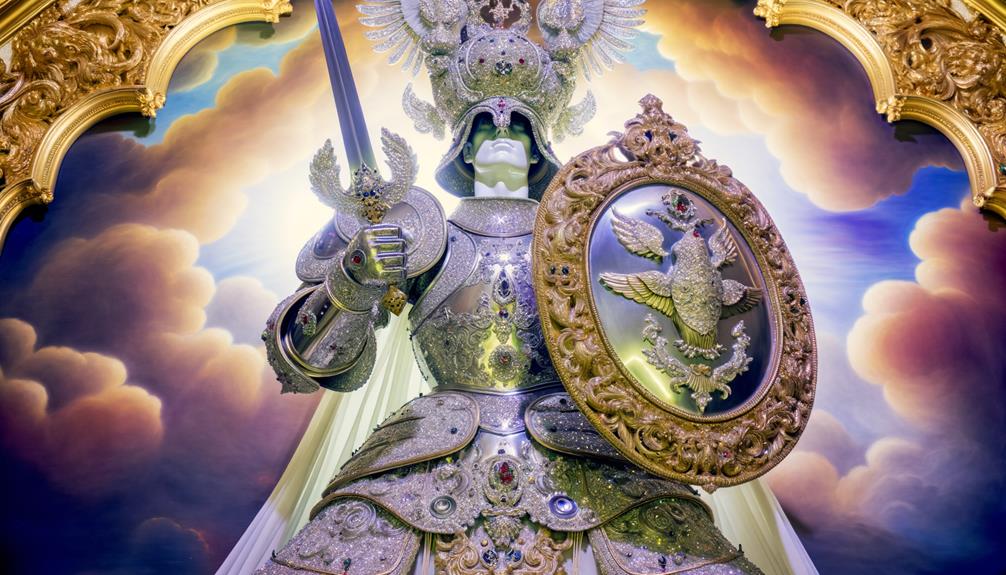
Building upon the themes of restoration and acceptance illustrated by the Prodigal Son’s robe, the concept of spiritual armor and clothing in biblical texts offers a profound exploration of divine protection and moral fortitude.
Ephesians 6:10-18 famously outlines the ‘Armor of God,’ metaphorically depicting the spiritual defenses available to believers. This passage emphasizes:
- Belt of Truth: Symbolizing honesty and integrity as foundational virtues.
- Breastplate of Righteousness: Representing moral rectitude and divine approval.
- Shield of Faith: Denoting trust in divine providence to ward off spiritual adversaries.
These elements collectively underscore the necessity of embodying divine principles to navigate moral and spiritual challenges.
The imagery of spiritual armor and clothing consequently serves as a critical framework for understanding the interplay between divine support and human virtue in biblical literature.
Conclusion
In examining the biblical narratives, garments emerge as powerful symbols, embodying divine favor, spiritual authority, repentance, and transformation.
From Joseph’s multicolored coat to Jesus’ seamless robe, each garment carries profound theological significance.
The Bible’s portrayal of clothing serves not merely as physical attire but as metaphors for deeper spiritual truths.
Consequently, biblical garments weave a rich tapestry of meanings, illustrating the intersection of the divine and the human condition, much like threads intricately interwoven into a fabric of faith.






